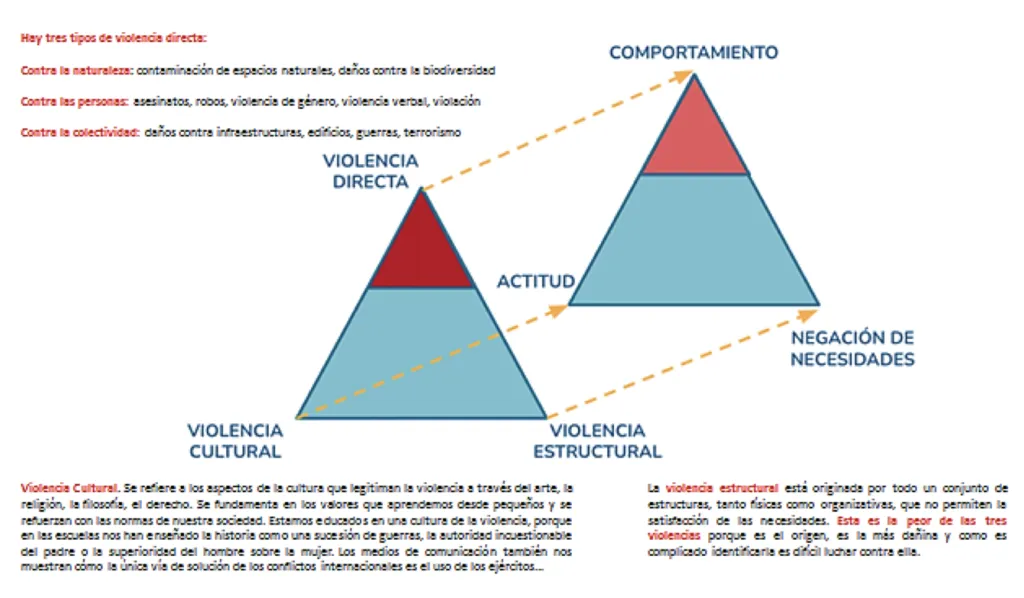Origins of Violence

Discover insights about origins violence and their relevance in today's dynamic business environment.
There are three types of direct violence:
-
Against nature: pollution of natural spaces, damage against biodiversity.
-
Against people: murders, robberies, gender violence, verbal violence, rape.
-
Against the collectivity: damage against infrastructures, buildings, wars, terrorism.
Cultural Violence
Cultural Violence refers to the aspects of culture that legitimize violence through art, politics, philosophy, law. It is based on the values we learn from childhood and are reinforced by the norms of our society.
We are educated in a culture of violence, because in schools we have been taught history as a succession of wars, the unquestionable authority of the father or the superiority of men over women.
The media also show us how the only way to solve international conflicts is the use of armies.
Structural Violence
Structural violence is originated by a whole set of structures, both physical and organizational, that do not allow the satisfaction of needs.
This is the worst of the three violences because it is the origin, it is the most harmful and it is difficult to fight against it because it is difficult to identify.
Years of Life Potentially Lost1502
One way to measure violence in general is the Years of Potential Life Lost (YPLL) indicator, which illustrates the loss suffered by society as a result of the death of young people or premature deaths. The assumption on which YPLL are based is that the more premature the death, the greater the loss of life.
The YPLL are a health indicator that measures the loss of life that occurs when a person dies before the expected age. YPLL are a tool to assess the impact of diseases and health and safety problems in society.
Mexican society experienced a decrease of up to six years in life expectancy as a result of the pandemic. However, in the year prior to the pandemic, there had already been 703,047 deaths, of which 32,079 were homicides, representing 4.6% of total deaths.
If we apply 4.6% to the life expectancy of 75 years, we obtain that Mexico lost approximately 3.5 years in its life expectancy at birth.
Life expectancy can have important differences between countries and even between states in the case of measuring it in a subnational way. Between Nuevo León and Chiapas there are five years of difference in life expectancy; or eighteen places between Aguascalientes and Zacatecas.
Homicides in Mexico
Homicides are high-impact crimes whose rate of intentional homicides per 100,000 inhabitants largely represents the violence that exists within countries.
The ranges go from less than one per 100,000 —as in the case of Australia or the Nordic countries— to 20 or 44 intentional homicides per 100,000 inhabitants —in African or Latin American countries, such as Mexico.
In the case of Mexico, there are six states that concentrate practically half of the intentional homicides: Guanajuato, State of Mexico, Baja California, Chihuahua, Michoacán and Jalisco.
For the United Nations, human security is the absence of need and fear. To the extent that we have our primary and complementary needs satisfied —in addition, if our environment enjoys trust— it leads us to not be afraid and enjoy a life without violence.
The perception of insecurity has a lot of correlation with the number of registered crimes.
The 2030 Agenda establishes a vision of “peaceful, just, violence-free societies based on respect for human rights […] in an effective rule of law and good governance at all levels, institutions become transparent and effective and bear fruit for peace.”
More Articles

Aguascalientes Industry Performance as of July 2025: INEGI Report Unveils Key Insights
Nov 10, 2025

Mexico and France Agree to Strengthen Commercial Ties
Nov 9, 2025

Who Will Benefit from the Minimum Wage Increase in Querétaro?
Dec 3, 2025

Auto Brands with the Sharpest Declines in Exports and Production Year-to-Date 2025
Nov 7, 2025

The Economic Value of Unpaid Domestic Work in Aguascalientes
Nov 25, 2025

"Live Commerce" Revolutionizes Sales: Up to 4000% Growth Propels Creative Micro-Entrepreneurs
Nov 18, 2025
